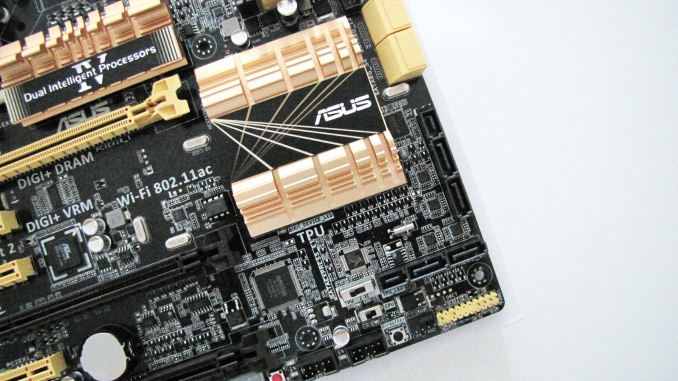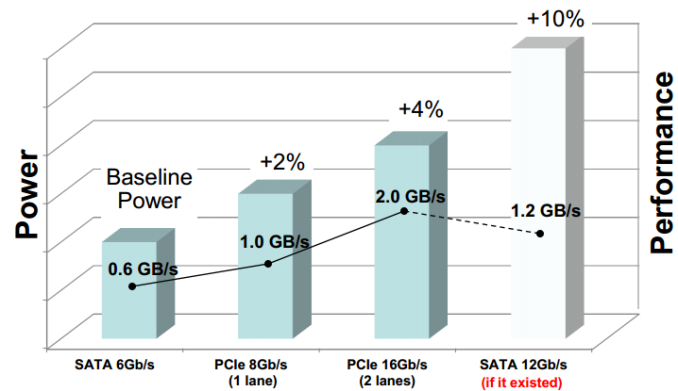Testing SATA Express And Why We Need Faster SSDs
by Kristian Vättö on March 13, 2014 7:00 AM EST- Posted in
- Storage
- SSDs
- Asus
- SATA
- SATA Express

During the hard drive era, the Serial ATA International Organization (SATA-IO) had no problems keeping up with the bandwidth requirements. The performance increases that new hard drives provided were always quite moderate because ultimately the speed of the hard drive was limited by its platter density and spindle speed. Given that increasing the spindle speed wasn't really a viable option for mainstream drives due to power and noise issues, increasing the platter density was left as the only source of performance improvement. Increasing density is always a tough job and it's rare that we see any sudden breakthroughs, which is why density increases have only given us small speed bumps every once in a while. Even most of today's hard drives can't fully saturate the SATA 1.5Gbps link, so it's obvious that the SATA-IO didn't have much to worry about. However, that all changed when SSDs stepped into the game.
SSDs no longer relied on rotational media for storage but used NAND, a form of non-volatile storage, instead. With NAND the performance was no longer dictated by the laws of rotational physics because we were dealing with all solid-state storage, which introduced dramatically lower latencies and opened the door for much higher throughputs, putting pressure on SATA-IO to increase the interface bandwidth. To illustrate how fast NAND really is, let's do a little calculation.
It takes 115 microseconds to read 16KB (one page) from IMFT's 20nm 128Gbit NAND. That works out to be roughly 140MB/s of throughput per die. In a 256GB SSD you would have sixteen of these, which works out to over 2.2GB/s. That's about four times the maximum bandwidth of SATA 6Gbps. This is all theoretical of course—it's one thing to dump data into a register but transferring it over an interface requires more work. However, the NAND interfaces have also caught up in the last couple of years and we are now looking at up to 400MB/s per channel (both ONFI 3.x and Toggle-Mode 2.0). With most client platforms being 8-channel designs, the potential NAND-to-controller bandwidth is up to 3.2GB/s, meaning it's no longer a bottleneck.
Given the speed of NAND, it's not a surprise that the SATA interface quickly became a bottleneck. When Intel finally integrated SATA 6Gbps into its chipsets in early 2011, SandForce immediately came out with its SF-2000 series controllers and said, "Hey, we are already maxing out SATA 6Gbps; give us something faster!" The SATA-IO went back to the drawing board and realized that upping the SATA interface to 12Gbps would require several years of development and the cost of such rapid development would end up being very high. Another major issue was power; increasing the SATA protocol to 12Gbps would have meant a noticeable increase in power consumption, which is never good.
Therefore the SATA-IO had to look elsewhere in order to provide a fast yet cost efficient standard in a timely matter. Due to these restrictions, it was best to look at already existing interfaces, more specifically PCI Express, to speed up the time to the market as well as cut costs.
| Serial ATA | PCI Express | |||
| 2.0 | 3.0 | 2.0 | 3.0 | |
| Link Speed | 3Gbps | 6Gbps |
8Gbps (x2) 16Gbps (x4) |
16Gbps (x2) 32Gbps (x4) |
| Effective Data Rate | ~275MBps | ~560MBps |
~780MBps ~1560MBps |
~1560MBps ~3120MBps (?) |
PCI Express makes a ton of sense. It's already integrated into all major platforms and thanks to scalability it offers the room for future bandwidth increases when needed. In fact, PCIe is already widely used in the high-end enterprise SSD market because the SATA/SAS interface was never enough to satisfy the enterprise performance needs in the first place.
Even a PCIe 2.0 x2 link offers about a 40% increase in maximum throughput over SATA 6Gbps. Like most interfaces, PCIe 2.0 isn't 100% efficient and based on our internal tests the bandwidth efficiency is around 78-79%, so in the real world you should expect to get ~780MB/s out of a PCIe 2.0 x2 link, but remember that SATA 6Gbps isn't 100% either (around 515MB/s is the typical maximum we see). The currently available PCIe SSD controller designs are all 2.0 based but we should start to see some PCIe 3.0 drives next year. We don't have efficiency numbers for 3.0 yet but I would expect to see nearly twice the bandwidth of 2.0, making +1GB/s a norm.
But what exactly is SATA Express? Hop on to next page to read more!











131 Comments
View All Comments
mkozakewich - Friday, March 14, 2014 - link
Ooh, or what if we had actual M.2 slots on desktop motherboards that could take a ribbon to attach 2.5" PCIe SSDs?phoenix_rizzen - Thursday, March 13, 2014 - link
Yeah. Seems strange that they wouldn't re-use the M.2 or mSATA connector for this. Why take up 2 complete SATA slots, and add an extra connector? What are they doing with the SATA connectors when running in SATAe mode?It amost would have made sense to make a cable that plugged into <whatever> at the drive end, and just slotted into a PCIe x1 or x2 or x4 slot on the mobo. Skipped the dedicated slot entirely. Then they wouldn't need that hokey power dongle off the drive connector.
frenchy_2001 - Friday, March 14, 2014 - link
They were looking for backward compatibility with current storage and in that context, the decision makes sense. No need to think about how to plug it, it just slots right where the rest of the storage goes and can even accept its predecessor.It's a desktop/server/storage centric product, not really meant for laptop/portable.
But I agree its place is becoming squished between full PCIe (used already in data centers) and miniPCIe/M2 used in portables. As the requirement is already 2x PCIe lanes (like the others), it will be hard to use for lots of storage and if you cannot fit 24 of those in a rack (which is how most server use SATA/SAS), as few servers have 48 lanes of PCIe hanging around unused then it seems only reserved to desktop/workstation and those can easily use PCIe storage...
phoenix_rizzen - Friday, March 14, 2014 - link
Yeah, until you try to connect more than 2 of those to a motherboard. And good luck getting that to work on a mini-ATX/micro-ATX board. Why use up two whole SATA ports, and still use an extra port for PCIe side of it?How are you going to make add-in controller cards for 4+ drives? There's no room for 4 of those connectors anywhere. And trying to do a multi-lane setup like SFF-8087 for this will be rediculous.
The connector is dumb, no matter how you look at it. Especially since it doesn't support power.
jasonelmore - Saturday, March 15, 2014 - link
it looks like the only reason to be excited about this connector is for using older Hard Drives 2.5 or 3.5 form factor, and putting them on a faster bus.Other than that, other solutions exist and they do it quicker and with less power. its just a solution to let people use old hardware longer.
phobos512 - Thursday, March 13, 2014 - link
It's not an assumption. The cabling adds distance to the signal path, which increases latency. Electrons don't travel at infinite speed; merely the speed of light (in a vacuum; in a cable it is of course reduced).ddriver - Thursday, March 13, 2014 - link
You might be surprised now negligible the effect of the speed of electrons is for the total overall latency.Khenglish - Thursday, March 13, 2014 - link
It's negligible.The worst cables carry a signal at 66% of the speed of light, with the best over 90%. If we take the worst case scenario of 66% we get this:
speed of light = 3*10^8 m/s
1m / (.66 * 3*10^8 m/s) = 5ns per meter
If we have a really long 5m cable that's 25ns. Kristian says it takes 115us to read a page. You never read less than 1 page at a time.
25ns/115us = .0217% for a long 5m cable. Completely insignificant latency impact.
willis936 - Thursday, March 13, 2014 - link
The real latency number to look at is the one cited on the nvme page: 2.8us. It's not so negligible then. It does affect control overhead a good deal.Also I have a practical concern of channel loss. You can't just slap a pcie lane onto a 1m cable. Pcie is designed to ride a vein of traces straight to a socket, straight to a card. You're now increasing the length of those traces, still putting it through a socket, and now putting it through a long, low cost cable. Asking more than 1.5GB/s might not work as planned going forward.
DanNeely - Thursday, March 13, 2014 - link
Actually you can. Pcie cabling has been part of the spec since 2007; and while there isn't an explicit max length in the spec, at least one vendor is selling pcie2.0 cables that are up to 7m long for passive versions and 25m for active copper cables. Fiberoptic 3.0 cables are available to 300m.